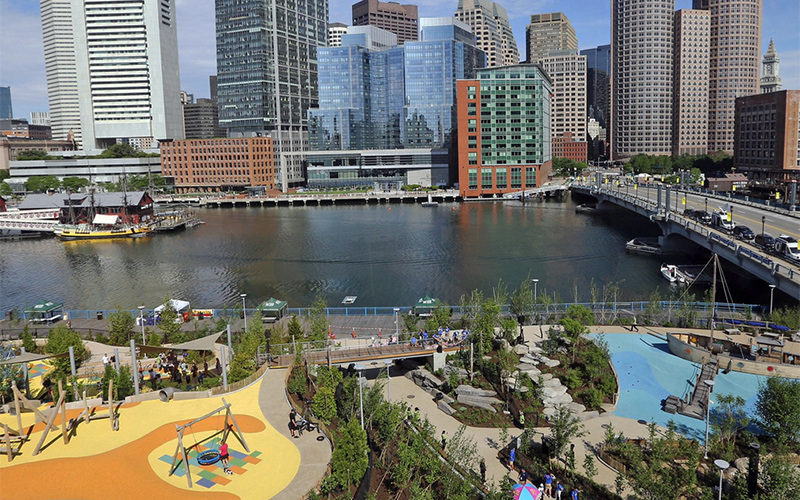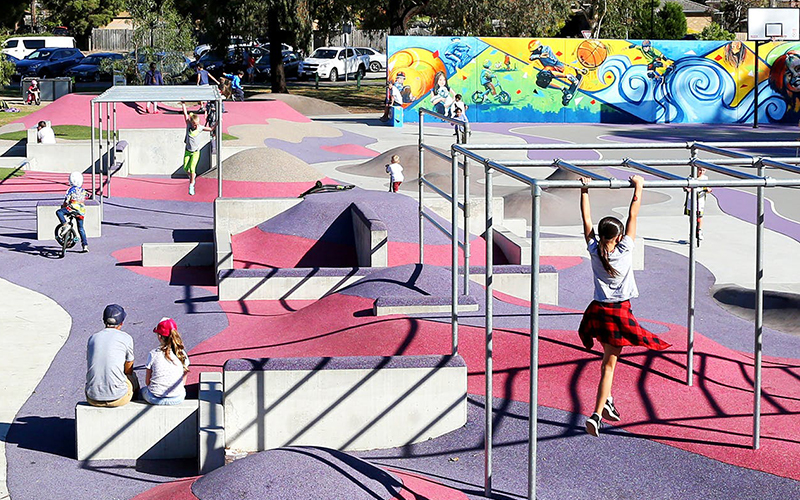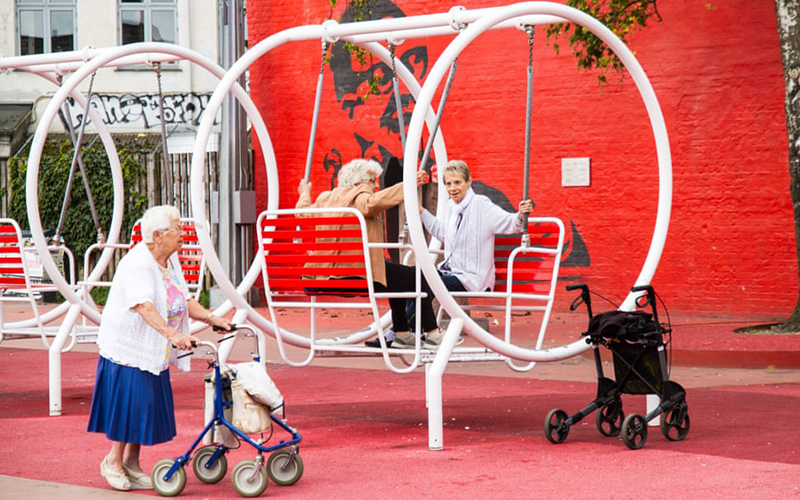Professional Practice
Universal Design: Playgrounds
 Martin’s Park balances the activity of an exciting playground with intimately scaled spaces, offering diminished sensory information to those who are overstimulated. Unlike many accessible playgrounds, elevation change is a central part of the experience. Sloping paths and bouldered hills allow everyone to access the various parts of the playground in whatever way they are comfortable. Martin’s Park, Boston, Massachusetts, Michael Van Valkenburgh Associates / Boston Mayor Marty Walsh Twitter
Martin’s Park balances the activity of an exciting playground with intimately scaled spaces, offering diminished sensory information to those who are overstimulated. Unlike many accessible playgrounds, elevation change is a central part of the experience. Sloping paths and bouldered hills allow everyone to access the various parts of the playground in whatever way they are comfortable. Martin’s Park, Boston, Massachusetts, Michael Van Valkenburgh Associates / Boston Mayor Marty Walsh Twitter Play is fundamental to human development throughout our lives. Playgrounds offer a focal point for play, but many people are unable to fully experience the opportunity provided due to the configuration of play spaces. Playgrounds are often designed to accommodate specific types of play or a certain age group, leaving children who are unable to play in the prescribed way left out of the play environment.
Playing is especially important for children with disabilities, allowing them to practice social skills. However, typical playground design is often not conducive to children with disabilities, leaving them over–or under–stimulated. Visiting typical playgrounds with children with disabilities can reveal what aspects of playground design do not accommodate everyone.
Playgrounds should create opportunities for intergenerational and social connections, sensory stimulation, physical exercise, and access to nature, the integration of which is a design problem. Designing with children with disabilities and their families and creating culturally-sensitive playgrounds show that playing is more than just fun and create spaces where everyone can play, regardless of ability, age, or language.
For example, Martin’s Park, designed by Michael Van Valkenburgh Associates (MVVA), is a universally designed playground. Unusual play structures and a large ship provide endless variations of play that can engage every child. The various methods of play have different means of access, allowing kids who are able to scramble up hills, while mobility-disabled children can use the sloping paths to reach the top. Interpretive signage points to the inclusive routes and elements of the playground. The inclusion of more than 350 trees and almost 700 shrubs give children, adults, and caregivers the chance to experience the sensory aspects of plants.
Universally-designed playgrounds feature:
Multiple forms of play: The multipurpose game settings and range of physical elements found in many playgrounds is critical for social and motor development. Sensory play is beneficial to all children, while allowing those with disabilities to play alongside abled children. Sensory play offers experiences that engage more senses than just visual, such as large scale musical instruments or fossil digs. Play spaces that appeal to a variety of senses enrich the play experience for everyone. Tactile play spaces help blind and low-vision children orient themselves and encourage them to engage in haptic play.
Range of risk: Unstructured, somewhat risky play is beneficial for children, but different children, and parents, are comfortable with different levels of risk. Accessible options offer different levels of risk and provide spaces for children of all abilities. These can range from low risk landforms, to having places to hammer and build objects.
Landform design: Unstructured play is a category of play that is open-ended and is critical to brain-development. Landform design is one tool landscape architects use to enhance sensory play and encourage unstructured play. Shaping the land to encourage kids to climb, roll, jump, and slide, among many other forms of play based on their own level of comfort and ability.
 Ballum Bumps has a series of small hills embedded within the park that allow children to create their own forms of play in relation to the landforms, rather than rely solely on equipment. Ballum Bumps Regional Playscape, Frankston, Australia, Playce / Playce
Ballum Bumps has a series of small hills embedded within the park that allow children to create their own forms of play in relation to the landforms, rather than rely solely on equipment. Ballum Bumps Regional Playscape, Frankston, Australia, Playce / Playce Ease of access: Some children are able to climb hills, while others need sloped pathways to reach the same location. Providing both options ensures that children of all abilities can play within the playground. Color delineations on the ground and play equipment allows children with low vision to distinguish between various elements of the playground. Visual connectivity between spaces allows for ease in signing and communication for deaf or hard of hearing children communicate and helps everyone better understand the organization of the playground.
Non-toxic, non-thorny plants: Plants provide excellent sources of sensory stimulation for all children, but especially for autistic, blind, or deaf children. Choosing safe plants ensures parents and caregivers can be comfortable with any level of sensory stimulation that anyone wants to receive from plants. Avoid using high-allergen plants whenever possible. Trees and other plantings provide shade for hot playgrounds.
Range of sensory engagement: Many autistic children are either over or under stimulated, creating the need for different intensities of sensory engagement throughout the playground. Providing small quiet places to play, in addition to the larger more engaging areas, allows children to play in the environment that best suits them. Wheelchair swings, or moving bridges, allow mobility-disabled children to enjoy these sensations. Items to manipulate, such as bells and latches, provide sensory engagement not directly related to play structures while promoting fine motor skill development.
Materials: Tactile and sensory-engaging materials should be balanced with materials that are easy to navigate for mobility-disabled children. Ground cover materials, including the surfaces of playground equipment and its surroundings, should be accessible to wheelchair users. Low-glare materials should be used throughout playgrounds, easing communication for children who use sign language and those with low vision. Steel, instead of plastic slides, can reduce static, which can be a concern for those with cochlear implants. Consider heat gain and cold retention properties of materials for those with temperature sensitivities.
Accessible equipment: Standard playground equipment isn’t accessible to all children. Supportive and wheelchair accessible swings expand who can use this equipment. Playground structures should have multiple options for transferring onto elevated elements, including paths wide enough for wheelchair users to turn around.
Interpretive signage: In playgrounds with multiple areas, signage should indicate where different types of sensory play is available. Clear signage with braille, and other tactile indicators at a height accessible to wheelchair users ensures adults and children of all abilities can understand the signage. Visual landmarks within the playground can help orient children as well.
Enclosure: Wandering can be prevented through efficient and clear safety measures. Features that limit risk of wandering give parents peace of mind while their children play. There are clear benefits to secure, gated fencing with a single entry point surrounding the perimeter of the entire playground. However, a mix of shrubs, well-placed logs, and other visual and/or physical barriers can also be effective in minimizing wandering or running concerns. If fencing is included, consider incorporating sensory panels and elements as part of the fence design.
Safe water and sand: Water is an excellent sensory stimulant for autistic, blind, and deaf children, but water elements should be designed with safety as the foremost concern so children of all abilities can play independently. Sand, along with water, has excellent play value for children of all abilities and can be dug or sculpted at the ground plane or in raised areas.
Ample seating: Seating should be spread throughout the playground, giving parents clear vantage points of the various spaces within the playground. Arm rests and chair backs should be included to accommodate everyone – waiting parents, older visitors, caregivers, kids, neighbors, those with endurance limitations, and others.
Play isn’t just for kids anymore, senior play spaces and public exercise equipment are popping up around the world. Play spaces for older adults provide health benefits and encourage engagement with their families and community.
 Superkilin Park features a series of facing chair swings with arm rests and backs. The seats are wide enough to fit two people, but still comfortable for one person alone. A nearby play structure for children offers chances for intergenerational play. Superkilin Park, Copenhagen, Denmark. Topotek 1, BIG Architects, and Superflex / Daryl Mulvihill
Superkilin Park features a series of facing chair swings with arm rests and backs. The seats are wide enough to fit two people, but still comfortable for one person alone. A nearby play structure for children offers chances for intergenerational play. Superkilin Park, Copenhagen, Denmark. Topotek 1, BIG Architects, and Superflex / Daryl Mulvihill Adult-oriented equipment: Parks should include adult-centered playgrounds where seniors can socialize through shared exercises and activities like Tai Chi. This can encourage them to engage with public space and maintain a presence in their communities.
Encourage exercise: Studies have found eccentric exercise can help reduce risk of developing dementia and help fight age-induced muscle atrophy. Accessible exercise equipment suited for different levels of mobility should be included.
Intergenerational play: Adult oriented equipment often looks like play structures, encouraging children and adults of all ages to play together. Intergenerational play reduces loneliness, encourages family bonding, and promotes active lifestyles.
Clear line of sight to restrooms: Restrooms should be located within sight of playgrounds, providing convenient access to everyone, especially children and those with cognitive disorders.
Organizations
Autistic Self-Advocacy Network
FitLot
Let Kids Play
Natural Learning Initiative
Shane's Inspiration
Star Institute for Sensory Processing Disorder
Unicef Hong Kong - Playwright Children's Play Association
Resources
AARP Fitness Parks
Evidence-Based Practices for the Design of Inclusive Playgrounds that Support Peer Interactions Among Children with All Abilities, MLA Thesis, Utah State University, 2017
Children and Nature Network 2018 Annual Report
Helping Your Child Cope with his Sensory Needs, The Hanen Centre
Inclusive Play Design Guide
In Defense of Play, The Atlantic, August 2016
Interview with Brian Johnston on the Landscape of Autism, The Dirt, October 2012
Playground Adaptions, Teaching Students with Visual Impairments
Playgrounds for Adults, AARP, March 2012
Processing Through Play, Landscape Architecture Magazine, July 2018
The Overprotected Kid, The Atlantic, April 2014
Through Play, Children with Autism can Hone Thinking Skills, Spectrum News, May 2016
Walking Down Stairs Could Help Prevent Dementia, Medical Xpress, June 2016
Why Cities Need Accessible Playgrounds, Curbed, July 2018
Research
The Importance of Play in Promoting Healthy Child Development and Maintaining Strong Parent-Child Bonds, Kenneth R. Ginsburg, MD, MSEd, the Committee on Communications, and the Committee on Psychosocial Aspects of Child and Family Health, January 2007
Occurrence and Family Impact of Elopement in Children With Autism Spectrum Disorders, Connie Anderson, Ph.D, J. Kiely Law, MD, Amy Daniels, Ph.D, Catherine Rice, Ph.D, David S. Mandell, ScD, Louis Hagopian, Ph.D, and Paul A. Law, MD, MPH, November 2012
Therapeutic potential of eccentric exercises for age-related muscle atrophy, Jae-Young Lim, June 2016
Projects
Brooklyn Bridge Park, Pier 6, Brooklyn, New York, Michael Van Valkenburgh Associates (MVVA), 2010
Ballum Bumps Regional Play Space, Frankston, AU, Playce, 2018 National Landscape Architecture Award, Play Spaces
Carbide Park Senior Playground, La Marque, TX, 2014
Harper's Playground, Portland, OR, Harper’s Playground
Helen Diller Playground at Mission Delores Park, San Fransisco, CA, Koch Landscape Architecture, 2012
Martin’s Park, Boston, MA, Michael Van Valkenburgh Associates (MVVA), 2019
Seattle Children’s Playgarden, Seattle, WA, Winterbottom Design Inc.
Superkilen, Copenhagen, Denmark, Topotek 1, BIG Architects, and Superflex, 2012